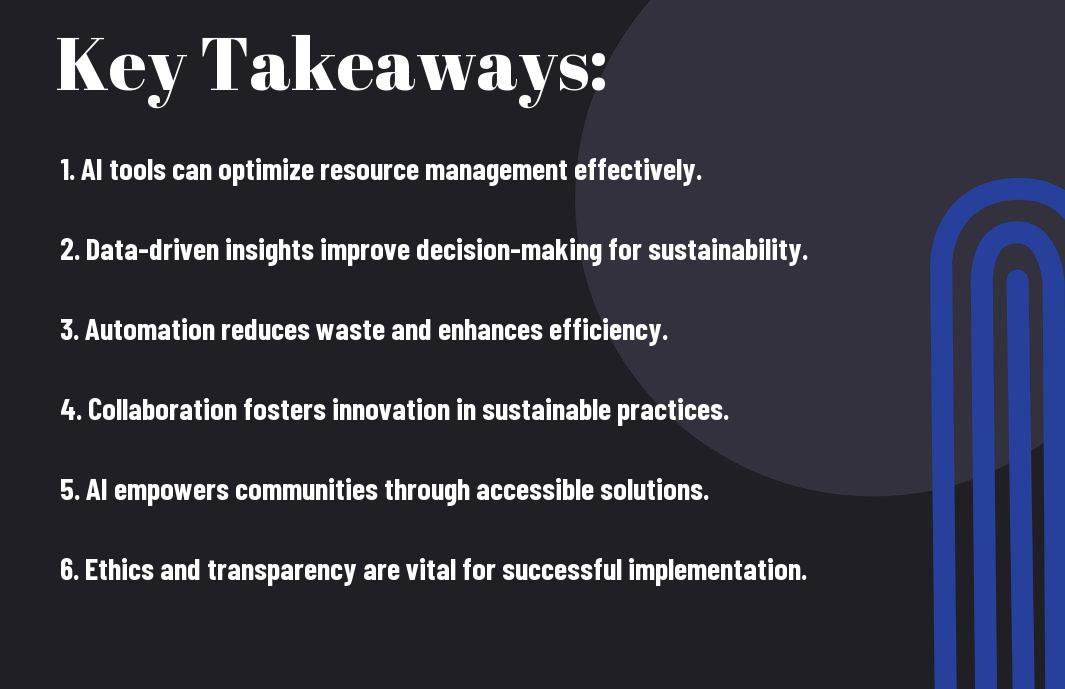Development in technology, especially in artificial intelligence (AI), presents a remarkable opportunity for you to address the pressing challenges of sustainable development. As you explore the capabilities of AI tools, it’s crucial to recognize their potential in enhancing resource efficiency, improving decision-making, and fostering innovation. This blog post will explore into how you can leverage these advanced technologies to create a more sustainable future, ultimately aligning your goals with the global imperative of sustainable development.

Key Takeaways:
- Integration: AI tools can be integrated into various sectors to enhance operations, improve decision-making, and drive sustainable practices.
- Efficiency: Utilizing AI can significantly increase resource efficiency, leading to reduced waste and lower carbon footprints.
- Data Analysis: AI facilitates advanced data analysis which can help in identifying trends and patterns for better targeting of sustainable development goals.
- Collaboration: AI fosters collaborations among stakeholders, enabling shared insights and pooled resources to tackle environmental and social challenges.
- Accessibility: Implementing AI can improve access to critical information and services in underserved communities, promoting inclusivity in sustainable development efforts.

Understanding AI Tools and Their Capabilities
The evolution of artificial intelligence (AI) has led to the development of tools that significantly enhance productivity and decision-making. These tools harness vast amounts of data and improve efficiency across various sectors by automating processes, offering insights, and predicting outcomes. By understanding these capabilities, you can leverage AI to promote sustainable development and tackle complex challenges effectively.
Definition and Types of AI Tools
Tools for artificial intelligence span a range of applications designed to simulate human intelligence in various ways. These can be broadly categorized as follows:
| Type | Description |
| Machine Learning | Algorithms that enable systems to learn from data. |
| Natural Language Processing | Allows machines to understand and respond to human language. |
| Computer Vision | Enables machines to interpret visual information. |
| Robotics | Involves creating intelligent agents that can perform tasks autonomously. |
| Expert Systems | Replicate decision-making abilities of human experts. |
After understanding these definitions and classifications, you’ll see how varied AI tools can be in their application.
Current Applications in Various Sectors
Any discussion about AI tools would be incomplete without considering their current applications across diverse sectors. From healthcare and education to agriculture and urban planning, AI is shaping the way we approach problems and find solutions.
In fact, sectors like healthcare rely on AI for predictive analytics and personalized treatment plans, while education utilizes adaptive learning platforms. Agriculture has embraced AI to enhance crop yields through data analysis, and urban planning increasingly uses AI-driven simulations to optimize resource allocation. By incorporating these tools, your organization can significantly contribute to sustainable development goals and drive meaningful change.
The Role of AI in Sustainable Development
Some of the most exciting advancements in artificial intelligence (AI) are now being harnessed for sustainable development. By leveraging AI technologies, you can improve processes across various sectors, fostering efficient resource management and eco-friendly practices. For instance, 4 ways AI can super-charge sustainable development highlight how these tools can create positive social, economic, and environmental impacts.
Enhancing Resource Efficiency
Any efforts you make to enhance resource efficiency can significantly contribute to sustainability goals. AI algorithms can analyze patterns in resource consumption, enabling you to optimize operations, reduce waste, and ensure the responsible use of materials across different industries.
Supporting Climate Change Mitigation
Around the world, the urgency to address climate change necessitates innovative solutions, and AI plays a vital role in this effort. By utilizing predictive analytics and machine learning, you can make informed decisions that decrease carbon emissions and promote sustainability.
At the forefront of climate change mitigation, AI technologies can enhance your ability to monitor and analyze environmental data. They provide insights into emissions sources, optimize energy consumption, and support renewable energy integration. By harnessing these capabilities, you can actively contribute to national and global initiatives focused on reducing your carbon footprint and fostering a sustainable future.
Challenges and Limitations of AI in Sustainability
Many factors hinder the integration of AI tools into sustainable development initiatives. The complexity of environmental systems, data quality, and accessibility issues pose significant challenges. Additionally, the varying levels of technological readiness across different regions can impede the widespread adoption of AI solutions. It is necessary to consider these limitations while exploring the full potential of AI in fostering sustainability.
Ethical Considerations
By promoting the use of AI for sustainability, it is vital to address ethical implications such as bias in algorithms, data privacy, and the potential for job displacement. Ensuring that AI systems are transparent, fair, and respect human rights is necessary for fostering public trust and achieving positive social outcomes in sustainability efforts.
Technical and Financial Barriers
Financial constraints and inadequate technical infrastructure can significantly impede the deployment of AI tools for sustainable development. Many organizations and communities may lack funding or expertise to implement advanced technologies, limiting their capacity to leverage AI for environmental goals.
Barriers to effective AI implementation extend beyond financial limitations. Technical challenges, such as insufficient digital infrastructure and data availability, can restrict access to AI-driven solutions, particularly in developing regions. To overcome these obstacles, you may need to explore partnerships, investment opportunities, and capacity-building initiatives that focus on enhancing skills and capabilities in using AI technologies for sustainability. Addressing these barriers is necessary to maximize the impact of AI on sustainable development efforts.
Case Studies of Successful AI Implementations
Not only are AI tools advancing rapidly, but their implementation for sustainable development is also yielding tangible results. Here are some noteworthy case studies:
- 1. IBM’s Green Horizon Project: Utilizing AI to predict pollution levels, leading to a 20% reduction in emissions in smart cities.
- 2. Microsoft’s AI for Earth: Invested $50 million in AI projects focusing on conservation and agriculture.
- 3. Google’s Environmental Insights Explorer: Provided data analytics to cities, resulting in 27% improvement in energy efficiency.
- 4. ClimateAI: Developing predictive models that increased agricultural resilience rates by 30% in drought management.
For a deeper investigate harnessing technology for environmental sustainability, check out Harnessing Technology for Environmental Sustainability.
Sector-Specific Examples
An vital aspect to explore is how AI can cater to various sectors. In agriculture, AI-driven precision farming is improving crop yields by up to 25%. In energy, AI optimization algorithms have enhanced renewable energy output by 30%. In urban planning, AI is streamlining waste management, reducing operational costs by 15%. These instances illustrate the versatility of AI in addressing sector-specific sustainability challenges.
Lessons Learned and Best Practices
Best practices in AI implementation reveal that collaboration between stakeholders is vital in achieving impactful outcomes. Moreover, investing in local talent and infrastructure strengthens sustainable initiatives.
Studies indicate that successful AI solutions often emerge from multi-sectoral partnerships, where government, academia, and industry unite for shared goals. Furthermore, leveraging data responsibly and ensuring transparency fosters trust and support from local communities. Engaging users in feedback loops can enhance the effectiveness of AI interventions, making them more attuned to actual needs.
Future Trends in AI for Sustainable Development
Unlike traditional approaches, the future of AI in sustainable development is set to transform industries with its ability to analyze vast datasets for informed decision-making. Expect innovations in predictive modeling, allowing you to anticipate environmental changes, optimize resource use, and advance community resilience. Additionally, AI can improve accessibility to sustainable practices, making it easier for you to integrate them into daily life and foster greater participation in sustainability initiatives.
Emerging Technologies
On the horizon, emerging technologies such as machine learning and blockchain are redefining the landscape of sustainable development. By harnessing these advancements, you can optimize supply chains, promote transparency in resource management, and reduce waste. The integration of AI with the Internet of Things further enables real-time monitoring and efficient resource allocation, enhancing your capacity to contribute positively to environmental goals.
Collaborative Efforts and Partnerships
Behind the scenes, collaborative efforts and partnerships between governments, NGOs, and private sectors are accelerating AI-driven sustainable development. By aligning diverse objectives and sharing resources, these stakeholders create a unified front against environmental challenges. Such partnerships enable you to leverage a wealth of expertise and funding opportunities, ultimately leading to more effective and widespread implementation of AI solutions.
Consequently, these collaborative endeavors catalyze innovative projects that target sustainability on multiple fronts. You’ll find that partnerships often lead to knowledge exchange, bringing together skill sets and resources that enhance overall impact. As you engage with various stakeholders, you can develop multifaceted approaches to local and global challenges. This synergy increases the likelihood of successful implementation of AI technologies while ensuring accountability and sustainability in outcomes.
Summing up
Considering all points, you can see that the integration of AI tools into sustainable development holds immense promise. By leveraging AI’s capabilities, you have the potential to enhance resource management, improve decision-making processes, and foster innovation. However, it is vital to navigate the challenges of ethics and equity to ensure that these tools serve your communities effectively. Ultimately, your engagement and thoughtful application of AI can create pathways towards a more sustainable future.